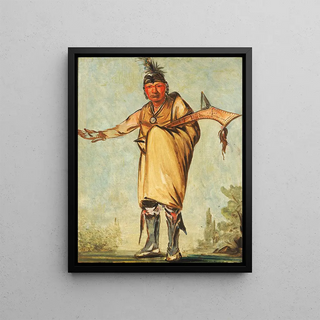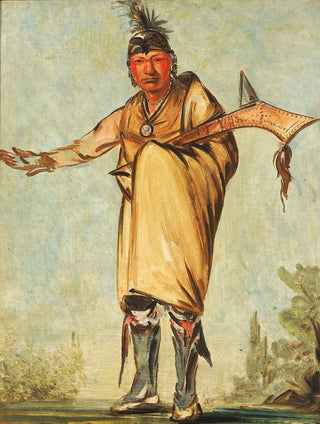Art print | Nw-kw Wood, former tribe chief - George Catlin


View from behind

Frame (optional)
In the vast panorama of art history, certain works stand out for their ability to transcend time and capture moments of rare intensity. The art print Nw-kw Wood, ancien chef de la tribu - George Catlin is a perfect example. This painting, not only a representation of a Native American chief, is also a poignant testimony of a bygone era, where art served as a bridge between cultures. George Catlin, as an artist and ethnographer, managed to immortalize iconic figures of Native American culture, offering us a valuable glimpse into their traditions and way of life. Through this piece, the viewer is invited to immerse themselves in a universe rich in history, where each brushstroke tells a story of pride and dignity.
Style and uniqueness of the work
The strength of the art print Nw-kw Wood, ancien chef de la tribu - George Catlin lies in its unique style, which combines realism and sensitivity. The artist, a master of color and light, manages to infuse a palpable life into his subjects. The meticulous details of traditional clothing, the depth of facial expressions, and the richness of colors evoke not only the physical appearance of the chief but also his spiritual essence. Catlin does not merely paint a portrait; he creates an emotional connection between the subject and the viewer. The background, often stripped down, highlights the central figure, thus emphasizing its stature and authority. This stylistic approach, both respectful and admiring, reflects Catlin’s commitment to representing Native American culture with authenticity and passion.
The artist and his influence
George Catlin, born in 1796, is an essential figure in 19th-century American art. His artistic journey is deeply marked by his fascination with the indigenous peoples of America. Traveling across the continent, he created hundreds of portraits and scenes of daily life of the tribes, becoming one of the first to document these disappearing cultures. Catlin’s influence extends beyond his time; his works continue to inspire generations of artists

Matte finish

View from behind

Frame (optional)
In the vast panorama of art history, certain works stand out for their ability to transcend time and capture moments of rare intensity. The art print Nw-kw Wood, ancien chef de la tribu - George Catlin is a perfect example. This painting, not only a representation of a Native American chief, is also a poignant testimony of a bygone era, where art served as a bridge between cultures. George Catlin, as an artist and ethnographer, managed to immortalize iconic figures of Native American culture, offering us a valuable glimpse into their traditions and way of life. Through this piece, the viewer is invited to immerse themselves in a universe rich in history, where each brushstroke tells a story of pride and dignity.
Style and uniqueness of the work
The strength of the art print Nw-kw Wood, ancien chef de la tribu - George Catlin lies in its unique style, which combines realism and sensitivity. The artist, a master of color and light, manages to infuse a palpable life into his subjects. The meticulous details of traditional clothing, the depth of facial expressions, and the richness of colors evoke not only the physical appearance of the chief but also his spiritual essence. Catlin does not merely paint a portrait; he creates an emotional connection between the subject and the viewer. The background, often stripped down, highlights the central figure, thus emphasizing its stature and authority. This stylistic approach, both respectful and admiring, reflects Catlin’s commitment to representing Native American culture with authenticity and passion.
The artist and his influence
George Catlin, born in 1796, is an essential figure in 19th-century American art. His artistic journey is deeply marked by his fascination with the indigenous peoples of America. Traveling across the continent, he created hundreds of portraits and scenes of daily life of the tribes, becoming one of the first to document these disappearing cultures. Catlin’s influence extends beyond his time; his works continue to inspire generations of artists






